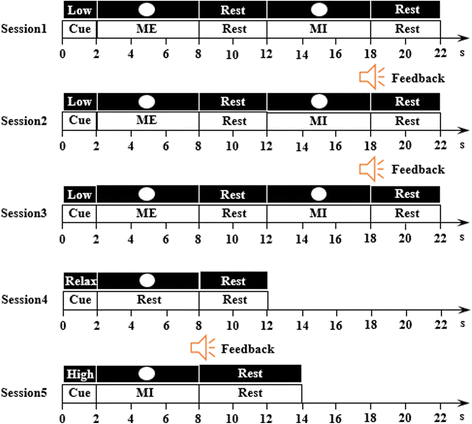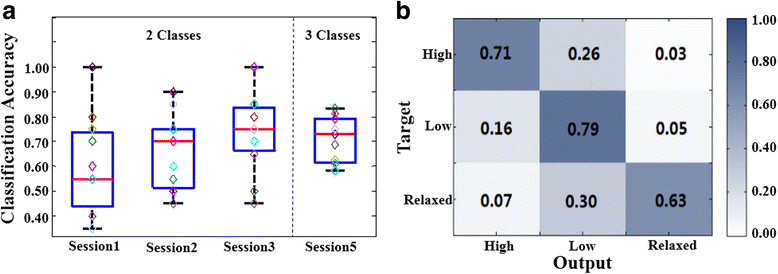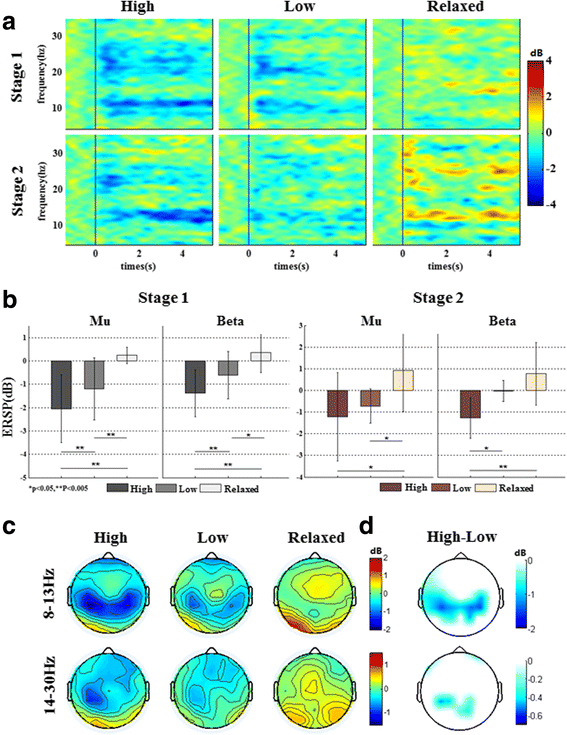A brain-computer interface driven by imagining different force loads on a single hand: an online feasibility study
- PMID: 28893295
- PMCID: PMC5594542
- DOI: 10.1186/s12984-017-0307-1
A brain-computer interface driven by imagining different force loads on a single hand: an online feasibility study
Abstract
Background: Motor imagery (MI) induced EEG patterns are widely used as control signals for brain-computer interfaces (BCIs). Kinetic and kinematic factors have been proved to be able to change EEG patterns during motor execution and motor imagery. However, to our knowledge, there is still no literature reporting an effective online MI-BCI using kinetic factor regulated EEG oscillations. This study proposed a novel MI-BCI paradigm in which users can online output multiple commands by imagining clenching their right hand with different force loads.
Methods: Eleven subjects participated in this study. During the experiment, they were asked to imagine clenching their right hands with two different force loads (30% maximum voluntary contraction (MVC) and 10% MVC). Multi-Common spatial patterns (Multi-CSPs) and support vector machines (SVMs) were used to build the classifier for recognizing three commands corresponding to high load MI, low load MI and relaxed status respectively. EMG were monitored to avoid voluntary muscle activities during the BCI operation. The event-related spectral perturbation (ERSP) method was used to analyse EEG variation during multiple load MI tasks.
Results: All subjects were able to drive BCI systems using motor imagery of different force loads in online experiments. We achieved an average online accuracy of 70.9%, with the highest accuracy of 83.3%, which was much higher than the chance level (33%). The event-related desynchronization (ERD) phenomenon during high load tasks was significantly higher than it was during low load tasks both in terms of intensity at electrode positions C3 (p < 0.05) and spatial distribution.
Conclusions: This paper demonstrated the feasibility of the proposed MI-BCI paradigm based on multi-force loads on the same limb through online studies. This paradigm could not only enlarge the command set of MI-BCI, but also provide a promising approach to rehabilitate patients with motor disabilities.
Keywords: Brain-computer Interface (BCI); Electroencephalogram (EEG); Event-related Desynchronization (ERD); Force load; Motor imagery.
Conflict of interest statement
Ethics approval and consent to participate
All participants provided written informed consent prior to participating in the study. The study was approved by the institutional review board of Tianjin University.
Consent for publication
Not applicable.
Competing interests
The authors declare that they have no competing interests.
Publisher’s Note
Springer Nature remains neutral with regard to jurisdictional claims in published maps and institutional affiliations.
Figures




Similar articles
-
EEG oscillatory patterns and classification of sequential compound limb motor imagery.J Neuroeng Rehabil. 2016 Jan 28;13:11. doi: 10.1186/s12984-016-0119-8. J Neuroeng Rehabil. 2016. PMID: 26822435 Free PMC article.
-
Unimanual Versus Bimanual Motor Imagery Classifiers for Assistive and Rehabilitative Brain Computer Interfaces.IEEE Trans Neural Syst Rehabil Eng. 2018 Dec;26(12):2407-2415. doi: 10.1109/TNSRE.2018.2877620. Epub 2018 Oct 25. IEEE Trans Neural Syst Rehabil Eng. 2018. PMID: 30371375
-
Modulation of event-related desynchronization during kinematic and kinetic hand movements.J Neuroeng Rehabil. 2014 May 30;11:90. doi: 10.1186/1743-0003-11-90. J Neuroeng Rehabil. 2014. PMID: 24886610 Free PMC article.
-
Electroencephalographic Motor Imagery Brain Connectivity Analysis for BCI: A Review.Neural Comput. 2016 Jun;28(6):999-1041. doi: 10.1162/NECO_a_00838. Epub 2016 May 3. Neural Comput. 2016. PMID: 27137671 Review.
-
From classic motor imagery to complex movement intention decoding: The noninvasive Graz-BCI approach.Prog Brain Res. 2016;228:39-70. doi: 10.1016/bs.pbr.2016.04.017. Epub 2016 May 31. Prog Brain Res. 2016. PMID: 27590965 Review.
Cited by
-
Separable EEG Features Induced by Timing Prediction for Active Brain-Computer Interfaces.Sensors (Basel). 2020 Jun 25;20(12):3588. doi: 10.3390/s20123588. Sensors (Basel). 2020. PMID: 32630378 Free PMC article.
-
Neural Representation of Observed, Imagined, and Attempted Grasping Force in Motor Cortex of Individuals with Chronic Tetraplegia.Sci Rep. 2020 Jan 29;10(1):1429. doi: 10.1038/s41598-020-58097-1. Sci Rep. 2020. PMID: 31996696 Free PMC article.
-
Brain-Computer Interface Channel-Selection Strategy Based on Analysis of Event-Related Desynchronization Topography in Stroke Patients.J Healthc Eng. 2019 Aug 28;2019:3817124. doi: 10.1155/2019/3817124. eCollection 2019. J Healthc Eng. 2019. PMID: 31559004 Free PMC article.
-
Effect of 3D paradigm synchronous motion for SSVEP-based hybrid BCI-VR system.Med Biol Eng Comput. 2023 Sep;61(9):2481-2495. doi: 10.1007/s11517-023-02845-8. Epub 2023 May 16. Med Biol Eng Comput. 2023. PMID: 37191865
-
Brain-computer interfaces: the innovative key to unlocking neurological conditions.Int J Surg. 2024 Sep 1;110(9):5745-5762. doi: 10.1097/JS9.0000000000002022. Int J Surg. 2024. PMID: 39166947 Free PMC article. Review.
References
MeSH terms
LinkOut - more resources
Full Text Sources
Other Literature Sources
Miscellaneous

